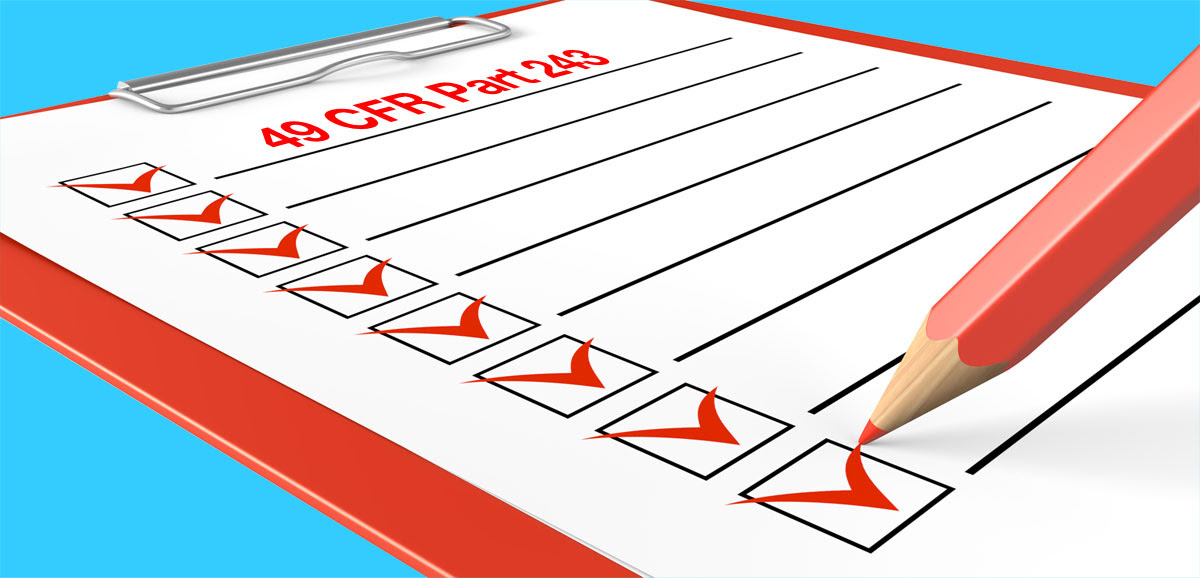As the first quarter of 2017 disappears in the rearview mirror many railroad managers are beginning to plan implementation of the requirements detailed in 49 CFR Part 243. In an effort to help set the table for those that need to comply with these new rules, here is a quick reference for the components that make up 243.
What needs to be done?
- Employee crafts must be categorized into occupational categories.
- Safety-related employees are designated to categories.
- Training programs are to be developed for each safety-related category of employees.
- Periodic oversight by designated supervisors will happen throughout the operation year.
- Annual reviews to assess training gaps must be conducted and documented by September 1 each year and maintained on file for review.
Who is a Safety-related Employee?
- Employees covered by the hours of service (HOS) laws.
- Employees performing work as an operating employee (including supervisors), even if
- not covered by the HOS laws.
- All engineering or maintenance-of-way (MOW) employees including bridge workers who inspect, install, repair, or maintain track, roadbed, signal, and communication systems.
- Mechanical personnel who inspect, install, or repair any locomotive, passenger car, freight car, or MOW vehicle.
- Any person who, as a primary duty, directly instructs, mentors, inspects, or tests others engaged in a safety-related task (including first-line supervisors of operating employees).
- Safety-related railroad employees include supervisors who determine that an on-track roadway maintenance machine or hi-rail vehicle may be used without repair of a noncomplying condition.
- Persons who perform oversight roles rather than doing the work themselves.
Dates to Know
Employers with >400,000 work hours annually (~200 FTEs):
Jan 1, 2018 – Program Implementation: Implementation of a 243 compliant Training, Qualification and Oversight program (program should be implemented in the case where a program has been submitted, but not yet approved by the FRA).
Sept 1, 2018 – Designate Employees: All employees performing safety-related service must be assigned to designated occupational category or subcategory.
Employers with <400,000 work hours annually (~200 FTEs):
May 1, 2019 – Program Implementation: Implementation of a 243 compliant Training, Qualification and Oversight program (program should be implemented in the case where a program has been submitted, but not yet approved by the FRA).
Feb 1, 2020 – Designate Employees: All employees performing safety-related service must be assigned to designated occupational category or subcategory.
Required Documentation
Employees
Employers are required to keep the following documentation for all employees performing safety-related service and for contractors not being documented by their organization.
- Employee name.
- Each occupational category or subcategory deemed qualified including date(s).
- Dates and title of each formal training course successfully completed.
- If the course was provided by an FRA-approved TO/LI, attach copy of transcript.
- OJT program unique name or identifier.
- Date OJT successfully completed.
- Name of person(s) who determined the employee is qualified to perform safety-related tasks in occupational category.
- Records retained for employees a minimum of 6 years after termination.
Program
Annual reviews to assess training gaps must be conducted and documented by September 1 each year and maintained on file for review.
Railroads that utilize contractor employees
- Contract employees who work “safety-related” occupations must be qualified by an FRA approved training program by either the contracting company or the railroad itself.
- If the contracting company provides the training, the railroad utilizing those employees must be provided records of contract employee qualification.
New Hire Employees
Safety-related employees qualified or trained by anyone other than the current employer may be deemed qualified provided:
- A record of training from the previous entity is obtained; or
- If no training records exist, the current employer may perform testing to assess the knowledge, skills, and abilities of the employee to be a member of the occupational category.



